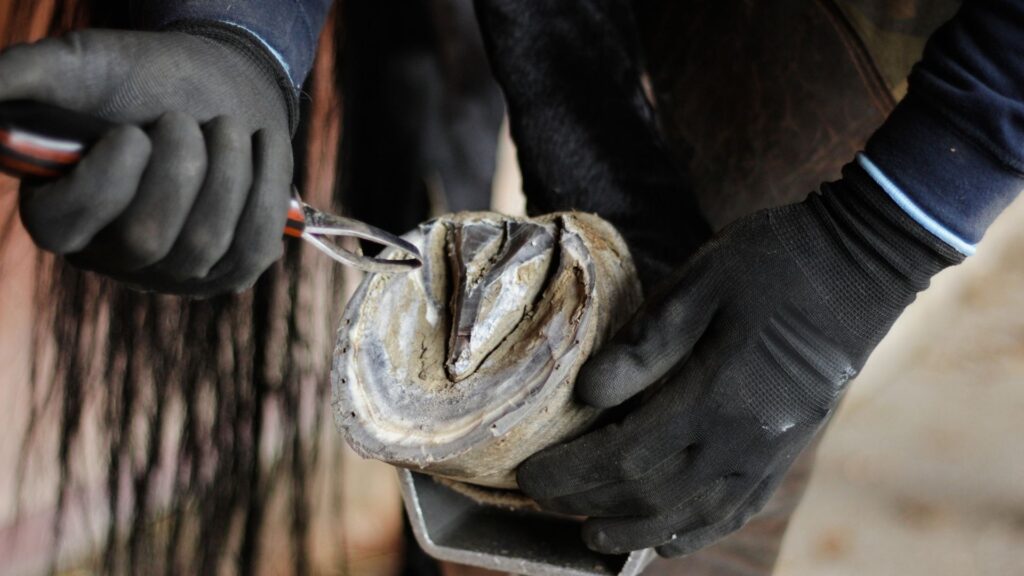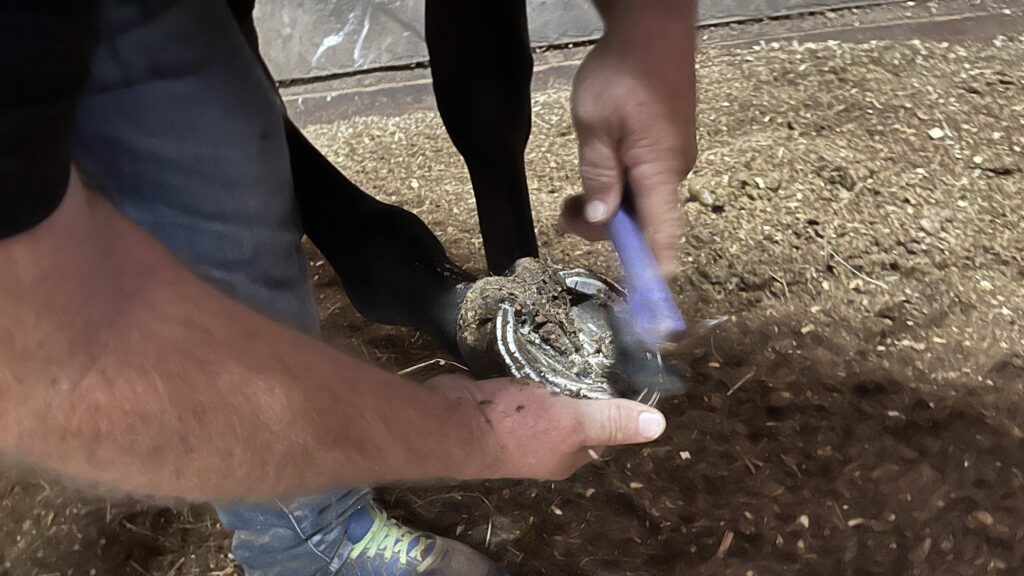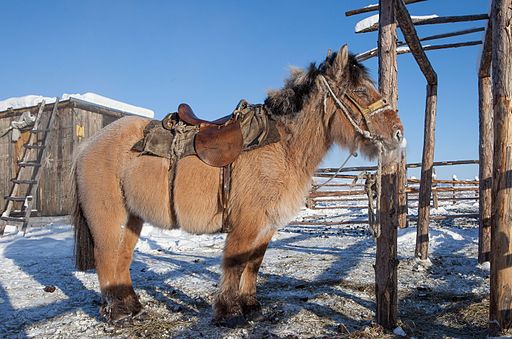Last updated: April 3, 2023
Any links on this page that lead to products on Amazon are affiliate links and I earn a commission if you make a purchase. Thanks in advance – I really appreciate it!
Most of our horses stand statuesque while shod; however, a young horse kept resisting our farrier. The colt’s reaction made me wonder if the farrier hit a nerve and if the horse felt pain in its hooves.
Horse hooves encompass several structures, including some that have nerves and feelings. However, the hoof’s outer wall, the location horseshoes are attached, is void of nerves and feelings; in fact, it’s made of keratin, similar to a human toenail.
Owners often buy a horse based on coat color or pedigree, but a horse is rendered useless without good feet. So horse owners need a firm understanding of basic equine foot anatomy.
Horse hooves are comprised of the wall, sole, and frog.
The wall is the protective outer shell of the horse’s foot that encompasses the coffin bone. The sole is the bottom of the horse’s foot, visible when you lift it.
The frog is the triangle located on the bottom of the foot; it starts near the heel and extends approximately halfway to the toe.

The outer walls of horse hooves do not have nerves.
Horseshoes are attached by nails driven through the shoe and into and through the horse’s hoof wall. The nails are driven at an angle to only go through the insensitive portion of the hoof.
Hoof walls continually grow; new growth begins at the top, where the hoof meets the skin. A typical horse hoof grows about 3/8 of an inch every 30 days. At this rate of growth, a horse has an entirely new hoof every year.
Horse hooves are primarily made of keratin.
The hoof wall is made of a rigid fibrous structural protein called keratin, which is the primary material in hair, nails, feathers, and hooves. The wall of the hoof has three sections or layers.
The hoof wall bears most of the weight of the horse and protects the inside of the hoof. It is the portion of the foot you see; the top connects to the coronary band, and looking from the bottom, it encircles the white line.
The front of the hoof wall is called the toe and is thickest in horses’ front feet; however, the toes of their rear feet are almost the same thickness around the foot. The rear of the hoof is the heel.
The heel of the hoof is pliable and flexes when downward pressure is applied. The heel is not as durable as the toe or sides of the foot and is susceptible to damage if trimmed by an inexperienced person.
Hoof walls have three layers.
The outer shell is tough, seals the hoof, and restricts moisture from escaping. Without moisture retention, the hoof wall is prone to dry and crack; if you suspect your horse is losing moisture through the outer hoof wall, coat it with a hoof conditioner.
The middle layer of the hoof is the densest, strongest, and most significant segment of the hoof wall. The inner layer wraps around, secures the hoof to the horse’s coffin bone, and provides additional protection to the inner foot.
The coffin bone is also known as the distal phalanx, the third phalanx, or the pedal bone. It is suspended above the sole and is critical to a horse’s health and blood circulation.

The sole of horses’ feet has nerves and feelings.
It’s not uncommon for a horse to get a stone bruise on its sole, nor is it unusual for thrush to develop in the sole. If you have dealt with either, you know the sole has nerves and feelings.
Horses with a stone bruise limp because of the pain they feel. On a correctly formed hoof, the sole does not touch the ground. The bottom of a hoof is made of keratin and continuously sheds its outermost surface. To keep a horse’s foot healthy, it’s essential to clean its hooves regularly.
It is typically about 1/2 inch thick and covers the coffin bone.
The frog has nerves.
The nerves in the frog are crucial and allow a horse to feel the surface it is standing on and know where its feet are in relation to its body. The frog is the strange triangle thing on the bottom of a horse’s foot. It begins at the heel and reaches midway to the toe.
It has grooves in the center and on each of its sides. It is pliable and contacts the ground. When pressure is exerted upward on the frog, it flattens and pushes the hoof wall outwards, and it also flattens the digital cushion.

Does it hurt horses’ feet to put horseshoes on?
When our horses get shod, our grandson typically holds the lead rope during the process. After watching a few horses, he asked us if it hurts the horse’s feet to nail shoes on.
If horseshoes are put on correctly, it doesn’t hurt a horse. Farriers are trained to attach the shoes with nails driven through the hoof walls where the hoof has no nerves or feelings. However, sometimes farriers drive a nail into the sensitive area of the foot and hurt a horse.
Some horse owners are moving towards riding horses barefoot, not because it hurts putting shoes on but because they believe horseshoes cause long-term damage to horses’ feet.
Do horses’ feet get cold in the snow?
I recently rode my horse on a frigid day, and my feet were freezing. My cold feet made me wonder if my horse’s feet were cold, too, especially since we traveled through water and snow.
Horses’ hooves don’t get cold; anatomically, their lower legs and feet are built for cold weather. Cold does not impact bones and tendons the same as it does muscle and soft tissue. And if you notice, from the knee down, a horse is primarily bone and ligaments.
Many horse owners like to wrap their horse’s legs in the winter for warmth; this practice may actually cause more harm than provide any benefit to the animal.
Horses tolerate cold better than humans.

Horses adapt to cold weather quite well; in the fall, their coats begin to grow, and by the time winter comes, most horse breeds’ coats thicken and provide protection against extreme temperatures.
For example, in Siberia, the Yakutian horse grows a winter coat of hair that reaches three inches. This breed can survive temperatures dipping to minus 95 degrees Fahrenheit without shelter. The horse looks like a furry stuffed animal with an unusually thick coat and long manes and tails.
Horses’ heavy coats trap warm air.
It’s not only their thick coat that protects them from the harsh Siberian winters; their manes and tails also provide protection. A horse’s mane lay over the side of its neck and shielded the cold wind.
Their long tails protect their rear end and underbelly from the wind blowing from the backside. A thick coat, mane, and tail also protect a horse’s skin from cold moisture.
During snowstorms, the natural oils in the hair keep the moisture at bay and encourage it to form an ice barrier to trap body heat but not melt. With hair three inches long, the Yakutian horse has an excellent warm barrier.
The horse’s respiratory system efficiently warms the air before it hits its lungs. Horses have guttural pouches on either side of their head to cool blood when working hard.
Still, they have the added benefit of warming the air before it reaches their lungs—thus allowing horses to breathe efficiently in cold temperatures humans could not tolerate.
Horses put on extra weight before winter.
Horses naturally carry extra weight into winter and lose it by spring. The excess weight is a layer of fat that insulates the body during cold temperatures.
The digestion process of hay and foliage is fuel for the horses’ internal heater, their hindgut. Foliage ferments in a horse’s hindgut and creates heat; as long as a horse eats grass or hay, its body continuously warms naturally.
Humans couldn’t survive these temperatures even with shelter.
Below is a helpful YouTube video showing the anatomy of a horse’s hoof.
FAQ
What is a horse hoof made of?
The hoof wall is made of a tough material made of keratin that is low in moisture. The hoof wall protects the sensitive inner structures of the hoof and helps to distribute the weight of the horse evenly across the foot.
Do horses like being shoed?
While most horses tolerate the process of being shod without any problems, there are some who do not like it. These horses may become agitated or restless when their hooves are handled, making it difficult for the farrier to do their job.
How often should you shoe your horse?
The frequency of shoeing depends on a number of factors, such as the horse’s breed, the type of terrain they live in, and how much they are ridden. However, most horses will need to be re-shod every four to six weeks. Regular shoeing is essential for maintaining the health of horses’ feet and preventing injuries.
Related articles:
- Do Thoroughbreds Have Bad Feet? 5 Traits of poor horse hoofs
- Horseshoes: Why Horses Need Them Plus Facts, Uses, and Types
- How, Why and When Horseshoes Need to Be Changed

About the Author: Miles Henry
Lifelong Horseman | Racehorse Owner | Published Author
Miles Henry brings over 25 years of hands-on experience training and owning Thoroughbred racehorses. Raised with Quarter Horses and Appaloosas, he’s spent a lifetime learning from horses—on the track, in the barn, and in the field. Today, he runs a small but successful racing stable in Louisiana and shares real-world insights on HorseRacingSense.com, helping horse owners, fans, and bettors navigate the sport with confidence.
📚 Books: View Miles’s books on Amazon »
🎧 Podcast Guest: Animal Tales Ep. 32 |
YouTube Interview
📩 Newsletter: Sign up for racing tips and horse care advice »
🔗 Follow Miles:
Twitter |
Facebook |
YouTube


